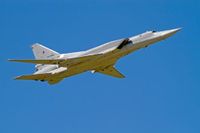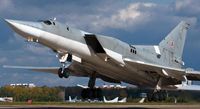In a significant development for the Russian military, a Tu-22M3 bomber crashed in the Irkutsk region on April 2, 2025, marking a notable loss for the Russian Air Force. This incident has raised concerns as it represents nearly 10% of the fleet of these strategic bombers, which are crucial for conducting airstrikes against Ukraine. According to Forbes, prior to this crash, Russia had approximately 60 modernized Tu-22M bombers, a remnant of Cold War technology capable of carrying various types of cruise missiles.
The recent crash, which occurred 2,700 miles from Ukraine, is part of a troubling trend for the Russian military. Before this accident, the Russian Air Force had already lost four Tu-22M bombers: one was shot down, one crashed, and two were destroyed or severely damaged in strikes by Ukrainian drones. The ramifications of these losses are profound, as they significantly impair Russia's ability to carry out its bombardments on Ukrainian cities, which have often targeted civilian populations.
The Tu-22M bombers have been under scrutiny not only for their aging design but also for their operational risks. Designed in the 1960s and built in the 1970s and 1980s, these aircraft are equipped with Kh-22 missiles, which, although still in production, also stem from the same outdated design era. Aviation expert Bill Sweetman humorously remarked, "Nothing is quite as interesting as flying with an ancient missile containing four tons of hypergolic fuel." This statement underscores the inherent dangers associated with operating such old technology in modern warfare.
The crash in Irkutsk is believed to be the fifth bomber lost by Russia since the onset of the full-scale invasion of Ukraine in 2022. Forbes estimates that the loss of these aircraft has also resulted in the destruction of a significant stockpile of cruise missiles, valued at nearly $1 billion, especially following a series of drone strikes on the Engels airbase between January and March 2025.
Despite these setbacks, Russian military officials remain undeterred. The Kremlin has stated that it will continue its airstrikes against Ukraine, citing that there are still ample serviceable Tu-22M bombers available, alongside other strategic bombers such as the Tu-95 and Tu-160. This assertion raises questions about the sustainability of Russia's air campaign, especially given the increasing frequency of drone strikes targeting their airbases.
In the wake of the crash, the Russian Ministry of Defense claimed that the bomber fell in a deserted area due to a "technical malfunction." They reported that while the crew attempted to eject, one pilot unfortunately did not survive the incident. This highlights not only the risks of flying outdated aircraft but also the potential for human loss in these military operations.
The ongoing political conflict between Russia and Ukraine continues to escalate, with both sides bracing for further confrontations. The situation remains tense, as the Ukrainian military prepares for potential retaliatory strikes while assessing the implications of Russia's air capabilities. The loss of the Tu-22M bombers, albeit significant, does not appear to deter Russia's military strategy, which continues to focus on overwhelming air assaults.
In summary, the recent crash of the Tu-22M3 bomber exemplifies the vulnerabilities within the Russian military's operational framework, particularly as it relates to aging aircraft and the ongoing conflict with Ukraine. While the losses are substantial, they do not seem to alter the course of Russia's military strategy, which remains focused on maintaining pressure through airstrikes and other military actions.
As the war progresses, both sides are likely to adapt their tactics, with Ukraine leveraging drone technology to counteract Russia's air superiority. The implications of these developments will be closely monitored by military analysts and observers worldwide, as they could signal shifts in the balance of power in the region.






